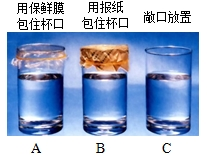(超市中的许多食物用保鲜膜包装后出售.保鲜膜为什么可以“保鲜”呢?
[设计实验]在A、B、C三只相同的玻璃杯中,分别注入等体积的蒸馏水,并在各玻璃杯外壁标明刻度,如图所示放置一周.
[实验现象]一周后发现:A杯中的水量几乎不变;而C杯中的水量减少较多;B杯中的现象是______.
[解释]请用分子的知识解释C杯中水量减少的原因:______.
[结论]保鲜膜除了可以阻止食物中水分流失,还能隔绝______,防止食物腐败.
[提出新问题]制作保鲜膜的材料是热固性塑料还是热塑性塑料呢?
[实验]在一只试管中放入少量保鲜膜碎片,用酒精灯缓缓加热,观察到碎片熔化,冷却后变成固体,加热又可以熔化.由此得出:制作保鲜膜的材料是______(填“热塑性”或“热固性”)塑料.
[反思](1)保鲜膜虽然能延长食品的保鲜期,但大量使用后丢弃会造成______,所以要控制使用.
(2)化学物质可以造福人类,但有时也会给人类带来危害,请你再举一例说明______.

[实验现象]塑料不透水,纸的透水性差,可以透过少量的水,所以B杯中的现象是:水量减少比A杯多,比C杯少.
[解释]水是由水分子构成的,水分子是不断运动的,杯中的水分子运动到了杯外.
[实验]塑料的透水、透气性很差,可以阻止食物中水分流失,还能隔绝氧气(或空气),防止食物由于缓慢氧化而腐败.
[反思]根据“保鲜膜碎片用酒精灯缓缓加热,观察到碎片熔化,冷却后变成固体,加热又可以熔化.”的信息可知,这种塑料有热塑性.
(1)难降解塑料长期堆积会污染土壤,污染地下水,危害海洋生物生存,燃烧还会产生有害气体.
(2)事物都是“一分为二”的,化学物质也是这样,有利的同时也有害,如二氧化碳可以灭火,但也能产生温室效应.
故答案为:[实验现象]:水量减少比A杯多,比C杯少;
[解释]:氧气(或空气);
[实验]:热塑性;
[反思]:(1)白色污染;
(2)二氧化碳可以灭火,但也能产生温室效应.
